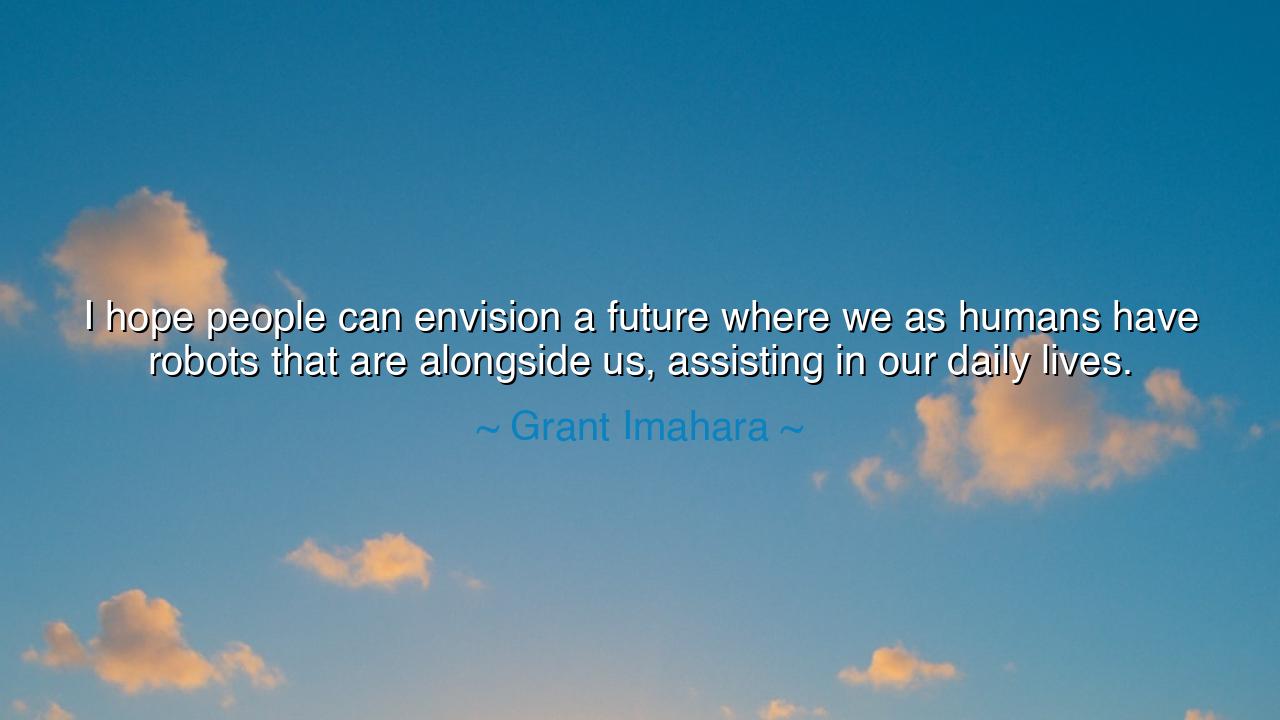
I hope people can envision a future where we as humans have
I hope people can envision a future where we as humans have robots that are alongside us, assisting in our daily lives.






"I hope people can envision a future where we as humans have robots that are alongside us, assisting in our daily lives." These words, spoken by Grant Imahara, offer a glimpse into the future—a future where the age-old dream of machines and humans working in harmony is realized. In the quiet corner of our imagination, we have long wondered about a world where technology becomes more than just a tool; it becomes a companion, helping to ease the burdens of daily life and allowing us to achieve greater heights. Imahara’s vision invites us to imagine a future where robots, those creations of mechanical ingenuity, do more than serve us—they walk beside us, making our lives more efficient, meaningful, and connected.
The idea of machines working alongside humans is not a modern creation, nor is it a mere fantasy. In ancient mythologies, the concept of mechanical helpers can be found. Consider the Greek myth of Talos, a giant, automated bronze figure created by the god Hephaestus to guard the island of Crete. Talos was not just a machine, but a protector—an extension of divine will designed to serve and assist humans in their daily struggles. The ancient Greeks, in their wisdom, saw the potential for creation to support humanity, just as Imahara envisions today. Talos represents an early understanding of the relationship between humans and artificial constructs—a relationship not born of fear, but of coexistence.
In more recent history, we find the idea of mechanical helpers in the visions of innovators such as Leonardo da Vinci, who designed early concepts of robots and machines intended to assist with human tasks. Da Vinci’s engineering sketches were not just technical drawings; they were expressions of a dream—a dream of a future where humans could push beyond their limitations with the help of machines. Though his designs did not come to life in his time, they laid the groundwork for the robots and machines that we would one day build. Just as Leonardo sought to harness the potential of mechanical assistance, Imahara’s words reflect the culmination of centuries of human ingenuity and imagination.
The concept of robots assisting humans is no longer confined to the realm of myth and imagination. It is fast becoming a reality. From the automated machines in factories to robotic prosthetics that restore mobility to those who have lost limbs, we are seeing the tangible results of a future once envisioned by pioneers like Imahara. These robots are not cold, detached machines; they are extensions of human capability—tools that amplify our potential and allow us to overcome obstacles that were once insurmountable. Robotics, in its many forms, serves not only to assist but also to enlighten, creating opportunities for people to live fuller, richer lives.
Yet, with this vision comes an important lesson. Throughout history, humans have sought to build machines to serve and empower, but they have also learned the importance of ensuring that these creations align with human values. The Industrial Revolution brought with it the mechanization of labor, but it also revealed the dangers of dehumanization—of allowing machines to take over without considering the consequences for individuals and communities. As we stand on the brink of this new age of robotic assistance, we must remember that technology, while powerful, must always be guided by wisdom and ethics. Just as Talos was a protector, so must we ensure that our creations are made to protect and enhance our humanity, not diminish it.
The lesson of Imahara’s vision, therefore, is twofold: first, to embrace the future of technology with an open mind, and second, to ensure that we do so with a sense of responsibility. The vision of robots walking alongside us—assisting in the tasks of daily life—is not just a call for innovation but a call for conscious creation. Humans and robots should not be adversaries but partners, working together to build a future where both are elevated. In our own lives, we must strive to create with purpose, to build not just for the sake of progress, but for the sake of a future where technology and humanity coexist in harmony.
Thus, as we look toward the horizon of this technological age, let us remember the ancient wisdom that tells us to build with care, to dream with ethics, and to always strive for a future where machines and humans stand side by side. The legacy of Leonardo da Vinci, Talos, and now Grant Imahara teaches us that the true potential of technology is realized not when it replaces us, but when it assists us in becoming our best selves. Let us walk into this future with hope, and with a commitment to ensuring that robots are not just tools, but partners in the great work of humanity’s advancement.






AAdministratorAdministrator
Welcome, honored guests. Please leave a comment, we will respond soon